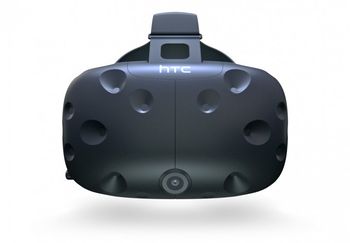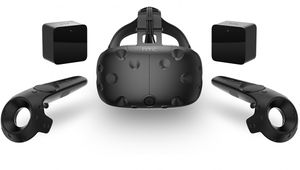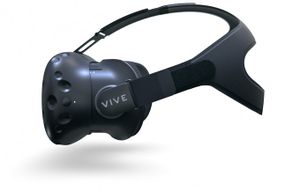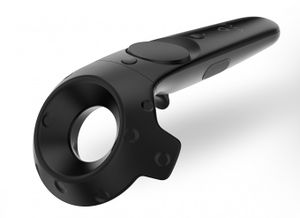HTC Vive
| HTC Vive | |
|---|---|

| |
| Basic Info | |
| VR/AR | Virtual Reality |
| Type | Head-mounted display |
| Subtype | Discrete HMD |
| Platform | SteamVR |
| Developer | HTC, Valve |
| Release Date | April 5, 2016 |
| Price | $799, €899, £689 |
| Website | http://www.htcvr.com/ |
| Requires | PC |
| Predecessor | HTC Vive Pre |
| Successor | HTC Vive CV2 |
| System | |
| Operating System | Windows |
| Storage | |
| Display | |
| Display | Dual Panel |
| Resolution | 2160 x 1200, 1080 x 1200 per eye |
| Pixel Density | ?? |
| Refresh Rate | 90 Hz |
| Image | |
| Field of View | 110°? |
| Optics | |
| Optics | Fresnel Lenses |
| Tracking | |
| Tracking | 6DOF |
| Rotational Tracking | Gyroscope, Accelerometer, Laser Position Sensor |
| Positional Tracking | Beacons |
| Update Rate | ?? |
| Tracking Volume | 120°H x 120°V (over 21 feet range) |
| Latency | ?? |
| Audio | |
| Audio | Built-in headphones, external headphones |
| Camera | Pass-through camera |
| Connectivity | |
| Connectivity | 2 HDMI ports, 2 USB ports, 1 headphone jack |
| Device | |
| Input | Controllers in both hands |
| Cable Length | 5+ meters |
- See also: HTC Vive Developer Editions
HTC Vive also known as HTC Vive CV1 or simply as the Vive is the first consumer version of HTC Vive Virtual Reality HMD developed by HTC. It is part of the SteamVR ecosystem created by Valve.
Pre-orders for the Vive begins on February 29, 2016 for $799. Vive released on April 5, 2016. HTC Vive CV1 comes with the head-mounted display, 2 wireless, motion tracked controllers and 2 lighthouse beacon positional sensors that enable room-scale VR.
Contents
Features
Frontal-facing camera
Vive Phone Services - Connect the HMD to your smartphone via Bluetooth, allowing the user to make and take calls and send and receive messages.
Hardware
Design and Ergonomics:
Display and Optics:
Tracking:
Voice and Audio:
Specifications
System Requirements
Recommended
- GPU: NVIDIA® GeForce® GTX 970, AMD Radeon™ R9 290 equivalent or better
- CPU: Intel® i5-4590 / AMD FX 8350 equivalent or better
- RAM: 4 GB or more
- Video Output: HDMI 1.4, DisplayPort 1.2 or newer
- USB Port: 1x USB 2.0 or better port
- Operating System: Windows 7 SP1, Windows 8.1 or later, Windows 10
SteamVR Performance Test
SteamVR Performance Test is a benchmark software that checks if your system is ready for Vive. It checks your system's OS, GPU and CPU to see if it has the capability of running VR at 90 FPS and whether VR content can tune the visual fidelity up to the recommended level.
Setup Tutorial
Software
Apps
HTC Vive CV1 is shipped with 3 free games: Job Simulator: The 2050 Archives by Owlchemy Labs, Fantastic Contraption by Northway Games and Tilt Brush by Google.
Connecting to Your Phone
Users can install the Vive mobile app on their phone from the App Store[1] or Google Play[2]. The apps enable your HTC Vive HMD to connect to your mobile phones through Bluetooth. It allows your Vive HMD to receive calls, texts and calendar reminders while your are in VR.
To make phone calls, users need to download the Vive software package [3] for their PC. Now when you receive a call or text, you'll be able to call back the individual through the Vive menu.
Developer
Accessories
Background
History
February 29, 2016 - Pre-orders for HTC Vive CV1 begin.
April 5, 2016 - HTC Vive CV1 is officially released.
Images
References
- ↑ https://itunes.apple.com/us/app/htc-vive/id1091173853?mt=8
- ↑ https://play.google.com/store/apps/details?id=com.htc.vivephoneservice&hl=en
- ↑ https://www.htcvive.com/us/setup/


